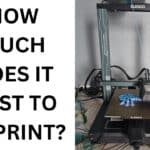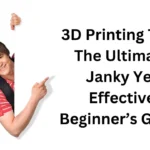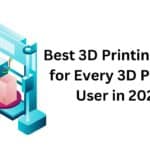
3D printed homes face hurdles like regulations and material limits, but innovations could soon tackle housing shortages, making affordable living a reality.
Imagine a world where building a house takes just a couple of days instead of months, and the costs are significantly lower than traditional construction methods. Sounds appealing, right? With the rise of 3D printing technology, many have envisioned this future. However, despite its potential, 3D printed homes have not yet become mainstream. Let’s explore why this innovative construction method is still on the fringes of the housing market.
Why 3D Printed Houses Aren’t Taking Over Yet
Affiliate Disclosure
We participate in Amazon affiliate programs, earning fees from qualifying purchases via links at no extra cost to you. It’s how we keep this blog rolling and my 3D printers buzzing with fresh filament for reviews like this one!
You might wonder, If 3D printing can revolutionize homebuilding, why isn’t it more common? This is a valid question that many people are asking as they see prototypes and small-scale projects popping up around the world. The reality is that while 3D printed houses offer exciting possibilities, several challenges hinder their widespread adoption.
1. Regulatory Hurdles
One of the most significant barriers to the adoption of 3D printed homes is the slow pace of regulatory change. Building codes and safety regulations often lag behind technological advancements. For instance, many regions have strict guidelines regarding construction materials and methods that do not yet account for 3D printing techniques. As noted by experts in the field, it can take years for these codes to adapt to new technologies, which delays the deployment of 3D printed homes in larger markets.
Inconsistent Building Codes
Local building codes vary widely across regions, and many have not yet been updated to include provisions for 3D printed structures. This inconsistency creates uncertainty for developers who want to invest in this technology but fear potential legal issues or delays in obtaining permits. Furthermore, some local governments may impose additional scrutiny on new technologies due to safety concerns, further complicating the approval process.
Safety Standards
The safety of 3D printed homes is another critical concern for regulators. Traditional construction methods have established safety standards based on decades of data; however, 3D printing is relatively new and lacks extensive historical data to demonstrate long-term durability and resilience against natural disasters like earthquakes or severe weather. As a result, regulatory bodies may require extensive testing and validation before allowing these structures to be built.
2. Public Perception and Acceptance
While 3D printed homes are gaining recognition for their affordability and speed, public perception remains a challenge. Many potential buyers are still unfamiliar with this technology and may harbor concerns about its safety and durability.
Familiarity with Traditional Homes
People tend to prefer traditional home designs that reflect established architectural styles and aesthetics. The often stark appearance of early 3D printed models can be off-putting to buyers who are accustomed to conventional homes. Overcoming this perception will require education about the design capabilities of modern 3D printing technology and showcasing successful projects that highlight its aesthetic potential.
Concerns About Quality
There are also concerns regarding the quality and longevity of 3D printed homes compared to traditionally built houses. Potential homeowners may worry about issues such as insulation, structural integrity, and maintenance needs over time. Until these concerns are addressed through rigorous testing and transparent reporting on performance metrics, widespread acceptance may remain elusive.
3. Skilled Labor Shortage
The transition to 3D printed construction requires a new set of skills that current labor forces may not possess. Traditional builders need training to operate complex 3D printers and understand new materials used in the process.
Training Challenges
The lack of trained professionals familiar with both construction practices and advanced technologies like 3D printing poses a significant challenge. Many construction workers may be hesitant to transition from traditional methods they are comfortable with to an emerging technology that requires specialized knowledge. This learning curve can slow down adoption rates as companies struggle to find or train workers proficient in this technology.
Investment in Education
To address this skills gap, investment in education and training programs will be essential. Collaborations between educational institutions, industry leaders, and government agencies could help develop curricula that equip workers with the necessary skills for operating 3D printers and managing construction projects using this technology.
4. Material Limitations
Currently, most 3D printing in construction relies heavily on concrete and some plastics. While these materials are effective, they may not provide the same structural integrity as traditional building materials like wood or steel in certain applications.
Structural Integrity Concerns
There are ongoing debates about whether concrete used in 3D printing can achieve the same strength and durability as conventional concrete used in traditional construction methods. Concerns about cracking during curing processes or long-term performance under various environmental conditions remain significant obstacles for builders considering this approach.
Limited Material Options
The limited range of materials suitable for 3D printing constrains design flexibility and innovation within the sector. While advancements are being made—such as experimenting with bio-based materials or composites—the current reliance on concrete restricts architects’ ability to explore diverse designs that could appeal to a broader market.
5. Economic Factors
Despite the promise of lower costs associated with 3D printing—thanks to reduced labor needs and material waste—initial investment costs for high-quality printers can be steep.
High Initial Costs
The upfront costs associated with purchasing or leasing advanced 3D printers can deter builders from adopting this technology, particularly when traditional construction methods remain more familiar and reliable. Additionally, ongoing maintenance costs for sophisticated equipment can add financial strain.
Long-Term Savings vs. Short-Term Costs
While proponents argue that the long-term savings from reduced labor costs and faster build times will ultimately offset initial investments, many builders remain cautious about making such financial commitments without clear evidence of reliability and efficiency over time.
The price for a 3D printed home typically ranges from $10,000 to $400,000. Smaller models can be built for less, while larger, more complex designs can be much more expensive.
The materials used in 3D printing homes (like concrete or specialized composites) can impact costs. For instance, some companies have reported using concrete mixtures that can cost around $100 to $200 per cubic yard.
The initial investment in 3D printing technology itself can be substantial. Industrial-grade 3D printers suitable for construction can range from $100,000 to several million dollars.
The Future of 3D Printed Homes
Despite these challenges, there is optimism about the future of 3D printed houses. Projects like ICON’s Wolf Ranch community in Texas demonstrate that large-scale applications are possible, with homes being built at a competitive price point compared to traditional housing.
Innovative Projects Around the World
Globally, various initiatives showcase successful implementations of 3D printed homes aimed at addressing housing shortages or providing affordable housing solutions for underserved communities. For example:
- ICON’s 3D Printed Homes in Austin, Texas: ICON has developed a 3D printing technology called Vulcan II, which can construct homes in as little as 24 hours. Their project includes a neighborhood of affordable, sustainable homes designed to address the housing crisis.
- New Story and ICON Collaboration: This partnership aims to build a community of 3D printed homes in Mexico for families in need. The project focuses on providing safe, durable housing using advanced construction techniques that can significantly reduce costs and construction time.
- Habitat for Humanity: In collaboration with ICON, Habitat for Humanity is exploring the use of 3D printing to create affordable housing solutions. Their pilot project aims to demonstrate how this technology can be used to address homelessness and housing shortages.
- The University of Nantes’ 3D Printed Housing Project: This initiative focuses on creating sustainable housing using 3D printing technology. The project emphasizes eco-friendly materials and energy-efficient designs, showcasing how 3D printing can contribute to sustainable architecture.
- Apis Cor’s Mobile 3D Printer: Apis Cor has developed a mobile 3D printer capable of constructing an entire house on-site within a few days. Their projects include a fully functional home built in Russia, demonstrating the feasibility of rapid construction using 3D printing.
These examples illustrate how organizations leverage innovative technologies like 3D printing to meet pressing social needs while also demonstrating feasibility through real-world applications.
Technological Advancements
As technology advances and public awareness grows, we may see a shift toward more widespread acceptance of this method in residential construction. Continuous research into improving materials used in construction will also contribute significantly toward overcoming existing barriers related to durability and performance.
11 Common Misconceptions about 3D Printed House

- 3D Printed Houses Are Incredibly Cheap: Many people believe that 3D printed homes can be built for as little as $5,000 to $10,000. In reality, the costs can be much higher due to various factors, including materials, labor, and equipment.
- A House Can Be Printed in 24 Hours: While some claims suggest that a house can be printed in a day, this often refers only to the printing time itself and does not account for the entire construction process, which typically takes longer than traditional building methods.
- You Can Just Press a Button to Print a House: The process of 3D printing a house is not as simple as pressing a button. It requires careful monitoring and management of multiple systems, including mixing materials and ensuring proper operation of the printer.
- 3D Printing Eliminates All Construction Waste: While 3D printing can reduce waste compared to traditional methods, it does not eliminate it entirely. Waste management remains a significant concern, and many companies do not recycle their materials effectively.
- All 3D Printed Houses Are Made of Concrete: A common misconception is that 3D printed construction is limited to concrete. In fact, various materials such as metals, polymers, and recycled materials can also be used in 3D printing for construction.
- 3D Printing Will Replace All Construction Jobs: There is a belief that 3D printing will take away jobs in the construction sector. However, it is more likely to change the nature of jobs rather than eliminate them entirely; skilled labor will still be needed for various aspects of construction.
- You Can Easily Move 3D Printing Equipment Anywhere: While it may seem straightforward to set up a 3D printer at any location by just adding water to the mix, the reality involves complex material science that requires careful preparation and testing specific to each site.
- The Technology Works Universally Without Adjustments: Many assume that if a 3D printing method works in one location, it will work elsewhere without modification. However, environmental factors such as humidity and temperature can significantly affect performance.
- All 3D Printed Structures Are Identical: There’s a misconception that all 3D printed houses look the same or have similar designs. In reality, there is significant variation in design and architecture based on individual projects and technological capabilities.
- 3D Printing Is Just a Fad in Construction: Some people view 3D printing as a temporary trend rather than a lasting innovation in construction. However, ongoing research and development indicate that it will play an increasingly important role in future building practices.
- The Market for 3D Printed Homes Is Saturated: While interest in 3D printed homes is growing, the market is still relatively new and has plenty of room for growth and innovation as technology advances and more players enter the field.
These misconceptions highlight the gap between expectations and reality regarding 3D printed houses, emphasizing the need for informed discussions about this emerging technology in the construction industry.
The global 3D printed construction market was valued at approximately $3.1 billion in 2020 and is projected to reach around $12.5 billion by 2027, growing at a compound annual growth rate (CAGR) of about 22.5%.
Conclusion
While there are significant hurdles to overcome before 3D printed houses become commonplace, ongoing innovations and changing perceptions could pave the way for this technology to play a crucial role in addressing housing shortages and affordability issues in the future. The journey may be long, but the potential benefits make it an exciting area to watch as it develops.
In summary, while regulatory hurdles, public perception issues, skilled labor shortages, material limitations, and economic factors currently impede widespread adoption of 3D printed homes, there is considerable promise for growth within this sector as advancements continue to unfold. By addressing these challenges collaboratively among stakeholders—including policymakers, builders, educators—and leveraging successful examples from around the world—the dream of affordable housing through innovative construction methods could soon become a reality rather than just an aspiration.













